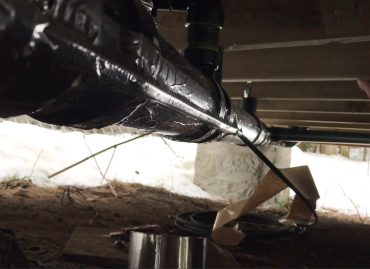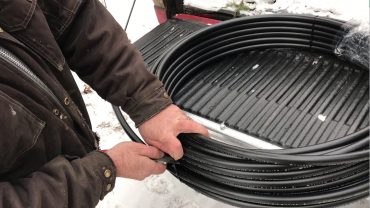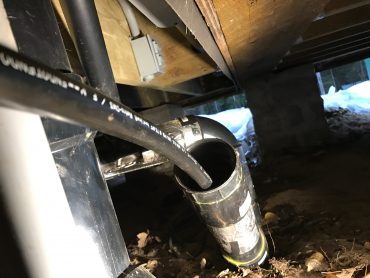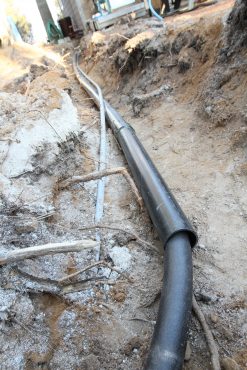
Steve Maxwell
How to keep outside water supply pipes from freezing – even in shallow soil conditions
Canadian ContractorTechnology from a small Ontario firm called Heat-Line is keeping pipes ice-free around the world
Beating the realities of winter is one of the challenges you face as a Canadian contractor, and things can get especially tricky when it comes to plumbing. Entire regions of this country don’t necessarily have the soil cover to protect water supply pipes and drain lines from freezing year-round. I’ve wrestled with shallow-soil building situations since the mid-1980s, I’ve tried a number of different approaches, and some of the best freeze-protection plumbing solutions I’ve found come from a small Canadian company in the land of rocks and trees.
Lorne Heise started out as an electrician, but after he and his wife Robin left the bustle of Toronto to live in the soil-poor, cottage-rich region of Muskoka, Ontario, they founded a company called Heat-Line (www.heatline.com; 800-584-4944). I first tracked Lorne down in 2011, following stories I’d heard about his water line freeze protection products installed around the world. You’ve probably never met anyone who gets as excited as Lorne does about the quintessential wintertime challenge of keeping pipes ice-free. Imagine spending a good part of each week inventing solutions for efficiently heating pipes! That’s Lorne’s life and he’s good at it.
When it comes to keeping pipes from freezing, water supplies and drain lines are two different animals. The risks of freezing are unique and so are the solutions. Both situations rely on electric heating cables, but the similarities end there.

Keeping Drain Lines Draining
As long as a drain pipe is sloped consistently and drains completely it might never get blocked with ice, even if it’s fully exposed underneath a raised building or buried by insufficient soil to keep the pipe above 0oC. But hope can be a dangerous thing when it comes to plumbing. If a blockage develops during winter in an otherwise reliable pipe, or frost builds up enough to clog the flow, it’s bad news. A 4-inch sewer line frozen solid with “ice” might not defrost until the robins have been back for weeks in most parts of Canada. And if something this ugly happens on one of your projects, you’ll look about as good as the stuff clogging your client’s sewer line.
Sizing Your Cable
So how do you make sure drain lines never freeze when you don’t have enough soil? It comes down to electric heating cables and there are two options: external and internal. Until recently, external was the only choice for drains because plumbing codes prohibit any electric cable from being located inside a drain pipe. The danger that code authorities are concerned about is the remote chance of an explosion caused by a spark surrounded by volatile sewer gases. External application of heating cable also side- steps the chance of pipe blockage caused by sewage debris grabbing onto an internal cable and building up, but there are factors to be considered when installing an external cable. Besides the fact that the external approach is difficult to install around buried drain pipes, the transfer of heat to frozen water is inhibited by the pipe wall.

Earlier this winter I installed two types of drain line heating cables. One fastens to the outside of a fully exposed insulated pipe underneath a building on raised piers, and the other sits inside a buried drain pipe. Heat-Line is unique in the world of heat trace systems because they have the only system that is cCSAus approved for use inside black and grey water drains. Their Retro-DWS system I installed includes a self-regulating heating cable that’s sealed inside a 1/2” diameter HDPE pipe. Technically speaking the cable is not inside a drain line, it’s inside a pipe that’s inside a drain line. This makes it okay for cCSAus certifications.

Another handy feature of the in-pipe approach is that you can push the heating cable a long way. You don’t need to fish it. In my own situation I easily pushed the pipe 130 feet from the building to a septic tank through a 4” PVC pipe. I’ve heard of situations where Retro-DWS was pushed a whopping 400 feet by hand without buckling.

Freeze-Proof Water Supply
There are many ways to keep water supply lines from freezing when they can’t be buried below the frost line, but the trick is making it all happen reliably and with minimal electricity use. The first time I installed a Heat- Line product for one of my projects was back in 2011. The situation involved a 55-foot run from a drilled well on a site with about 12” of stony soil above bedrock and I used a product called CARAPACE. It’s a 200 PSI high density polyethylene pipe with a self-regulating heating cable molded into one side.
In this case “self-regulating” means the heating cable increases heat output as needed in areas that are cold. One location on the cable may be drawing very little power because it’s naturally warm, while a colder section may be drawing more to prevent the pipe in that section from freezing. Coupled with a thermostat system that turns the entire system OFF when pipe temperatures rise above freezing and you have very frugal use of electricity.
The installation I put in included preformed foam pipe insulation around the water supply line, all encased in a 4” ABS pipe for physical protection. Where the water line turns upwards and goes vertical as it entered this particular home built on piers, I replaced the preformed foam sleeve with spray foam insulation injected into 3/8” holes in the ABS. I couldn’t make the curve inside the ABS with the sleeve insulation, but the spray foam injection did the trick. With the thermostat sensor located inside the coldest part of the installation (the vertical part above ground), the electricity switches ON less than half the time, even in the coldest weather.
Your projects only succeed as well as the weakest link performs, and frozen plumbing systems can cause no end of headaches. To see the job where I installed both the internal and external drain pipe heating cables, visit www.baileylineroad.com/freeze-proof-drains.
Advertisement
Print this page

I live in my cottage with wood stove for primary heat. My 4″ drain is suspended beneath in the cold crawlspace loosely wrapped with a roof defrost cable which is then wrapped with 1/2″ rock fibre pipe insulation set on a timer to activate for 1/2 hour at 3 am, 6:30 am, 1 pm, 7 pm, and 11 pm. Never freezes even at 30 below.
My water system consists of a submerged pump (lake) on a 1″ un-insulated pipe. The pressure tank is in the house and includes a check valve and an air bleeder valve to “drain back” to the pump. All of the internal water piping is pex 1/2″ and is above the floor on the warm side hidden behind the baseboards, cupboards etc. I had a 10 ft heat line at the lake but it burned out 1st winter. Now I have that section of pipe super insulated with 3 layers of foam pipe insulation inside a big O and a wound copper wire that brings free heat up from below. -Never freezes costs nothing to heat. (My hydro bill is $65 month) When I go away south I just pull the pex at the high end and blow hard to drain everything and lock the door. When I get back I flip the pump switch and we’re good to go! Beat that!
Hello Brad,
A word of caution:
I have great respect for your ingenuity!
If you have a plastic ABS or PVC pipe wrapped with a roof heating cable and insulated, you have created a fire hazard as you have supersceded manufacturers specifications and misapplied the product. Your roof heat tape likely has no high limit device to keep it from overheating so be careful. If you had a Heat-Line brand product burn out in the first year I hope you called the company. I have not heard of such a thing at Heat-Line in more than 30 years and I invented it. Perhaps you meant a heat tape and not my brand “Heat-Line”. I sincerely hope so.
We DIYers are limited by pricing when in a crunch. I have six rentals on one well house connection. Ingenuity caused me to use 200′ gutter heaterline on a 200′ waterhose waterline connecting two water wells together over a 5/8″ goodyear waterhose. I wrapped the line first with foil, lined with gutter heatline, then wrapped with closed cell pipe insulation. The hose is laying on the ground while the damaged well is replaced. Works great. It’s worked the past week. I don’t really care about your concerns in the previous message. It works for me and I don’t have quadruple $$$ to pay for required line you want to sell. And that’s what we humans do, we adapt or depend on someone else and fail.
I don’t fail at anything.
Please contact me, I have a question.
hi have no idea about how to go about this because i live in south fl but bought a cottage in tiny ontario last yr, its about 750 sq feet and is basically heated with a gas fireplace that we leave on all winter at 50 deg. we have a dug well at about 40 feet deep and a holding tank .The lady that owned it before lived there all winter for past 10 yrs but she did have electric base board heaters as well which we took out as they were old and we renovated. the house has an attic and has vapor barrier in it i know and has vinyl siding. so we really want to go up there for Christmas this yr but wanted to ask if that is even possible without draining all the pipes etc till the end if dec? or do we risk freezing and rupture of pipes and is it still possible to drain pipes at that late date? it has no basement it sits is on about a 2-3 foot crawlspace? Im so ignorant about this kind of thing . any advice would be so welcome !
Jane, please contact Steve Maxwell who wrote the article. He’s easily found online. Good luck.
that would be great but we are frozen now what can we do to unthaw it now
I would like to know if burrying pvc pipe on earth help as anti freeze during bad weather (snow fall)
I have waterline running
100 ft ftom my house to
Lake no heating cable
Year rnd water flow. No electricity.
Put 4 by 8 sm solid insulation
Sheets with thin plywood front and back bolted place over water line to lake.
Blow snow with snowblower at entrance into lake. In dec.
Never froze in 5 years
Info bicicle1955@gmail.com
Located parry sound ont.
Hi,
Thank you for giving information to keep outside water supply pipes from freezing – even in shallow soil conditions.
David Green, can you reply to me? Thanks.
Thank You Lorne
We bought a cabin in the Berkshires last year, was never used in the winter, water line from well is above ground under the cabin and only buried a few inches deep the 45 feet to the well head used 70 feet of heat line Retro pushed it into pipe and plugged it in, insulated pipe under cabin, snow melts on the rest of the line to the well head Never froze this past winter going to dig up the rest and insulate pipe to the well head this summer to make it more efficient. Heat line works if you cannot dig deeper because of ledge or rocks Heat line will work wish I got it 10 feet longer to go into the well now have to heat the well house. Made sweeping 90 degree fittings for this but did not count on winding track to the well head, so it was a bit short makes it to the well head but not into the well. great product great guarantee 5 years extendable to 10 years
Thank you so much to share the information, how can we ice-free pipes in the winter season. I generally face the problem of the freezing of supply pipes. Thanks a lot
Hello I have a cottage with an older style Heated cable inside 1”1/4 pvc pipe that pulls water from the lake.
My question is can I let this pipe freeze up? then when I come to the cottage at Christmas time turn the heated line on and wait for the pipe to thaw?
All fittings are pvc or plastic only the outside exposed part of the pipe would freeze the basement is heated so nothing inside would freeze.
Obviously the pump under the ice would not freeze as it’s 10ft down.
Please let me know your thoughts
Regards
Paul
My well is 300 feet from the house. What can I do to keep it from freezing to the house?
Very important! Thanks for sharing this information.